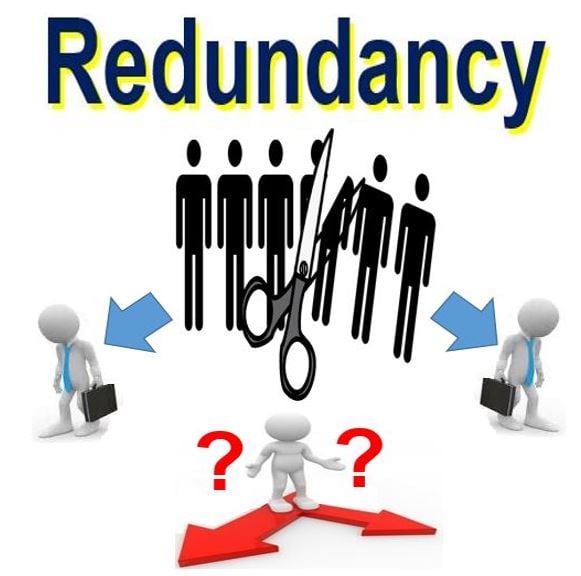Who Pays Redundancy Money? An In-depth Overview for Employers and Employees
Who Pays Redundancy Money? An In-depth Overview for Employers and Employees
Blog Article
Examining the Interplay Between Company Redundancy and Organizational Adaptability for Future Growth
In the vibrant landscape of today's business globe, the elaborate relationship between firm redundancy and organizational flexibility emerges as a crucial factor for continual growth and success. Firms typically face the difficulty of striking a delicate equilibrium in between keeping a degree of redundancy to minimize threats and promoting flexibility to react swiftly to the ever-evolving market needs.
Relevance of Firm Redundancy
Company redundancy is a vital aspect that improves organizational strength and alleviates operational threats. By integrating redundancy measures within the organizational structure, companies can much better endure unexpected interruptions and variations in the business environment. Redundancy offers as a critical buffer, enabling companies to adapt and react successfully to unforeseen obstacles without endangering essential operations.
One key aspect of the significance of company redundancy is its function in making sure continuity throughout times of dilemma. When faced with abrupt modifications or emergency situations, repetitive systems, resources, or workers can step in to keep essential features and stop widespread interruptions. This connection not just safeguards the company's online reputation and client trust fund however also reduces monetary losses and operational downtime.

Techniques for Business Flexibility

Producing versatile business structures that enable for fast changes to market characteristics and client demands is necessary for remaining competitive in a quickly evolving setting. By proactively determining prospective disturbances and possibilities, companies can proactively adapt and flourish in an ever-changing organization landscape.
Balancing Redundancy and Flexibility
Accomplishing a harmonious balance in between functional redundancy and organizational adaptability is extremely important in browsing the complexities of a dynamic service atmosphere. Redundancy within a business gives a safeguard, making certain connection and stability in procedures. However, an unwanted of redundancy can result in ineffectiveness and impede adaptability to transforming market problems. On the various other hand, organizational flexibility enables companies to react promptly to outside disruptions and take brand-new chances. Striking the ideal equilibrium in between redundancy and flexibility is a delicate process that calls for a deep understanding of the company's objectives, market dynamics, and threat resistance.
To accomplish this equilibrium, business need to perform routine analyses of their procedures to identify locations where redundancy is essential for risk mitigation and where adaptability can drive development and growth. Applying adaptable frameworks, promoting a society of moved here constant learning and improvement, and encouraging open communication throughout all levels of the company are essential techniques to balance redundancy and flexibility effectively. By aligning these 2 crucial components, companies can read what he said place themselves for lasting growth and success in an ever-changing service landscape.
Situation Researches on Adaptation Success
In checking out instances of successful business adaptation, it becomes apparent that the interaction between operational redundancy and versatility is a specifying variable in shaping durable companies. A DVD rental service, Netflix showed exceptional flexibility by transitioning into a streaming system when digitalization disrupted the sector. These case researches highlight the relevance of functional redundancy combined with business versatility in fostering long-lasting growth and competitiveness.
Structure Durability for Future Development
Structure resilience for future growth needs a tactical placement of operational processes with market characteristics and emerging patterns. Companies should adjust to transforming atmospheres by fostering a culture of adaptability, innovation, and constant improvement.
In addition, promoting strong partnerships with stakeholders, such as customers, staff members, distributors, and the neighborhood, is vital for maintaining and weathering uncertainties trust fund and assistance during turbulent times. Effective communication and transparency play an essential role in structure durability, as they help align assumptions and help with cooperation in browsing unpredictabilities.
In addition, companies require to focus on knowing and development campaigns to upskill staff members and furnish them with the essential tools to adjust to changing circumstances. By investing in their workforce, business can boost their versatility and dexterity, eventually enhancing their durability for lasting future development.
Final Thought

In the dynamic landscape of today's business world, the complex partnership between firm redundancy and business versatility emerges as a vital aspect for continual development and success. Firms typically face the obstacle of striking a delicate equilibrium in between keeping a level of redundancy to mitigate risks and promoting adaptability to react promptly to the ever-evolving market demands.To accomplish this balance, business require to perform normal analyses of their procedures to recognize locations where redundancy is required for risk mitigation and where versatility can drive development and development.In final thought, the interplay between company redundancy and business adaptability is essential for future growth. Structure durability with a combination of redundancy and adaptability will make sure that companies are prepared for the difficulties of the future.
Report this page